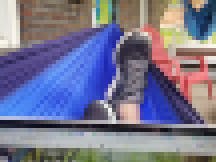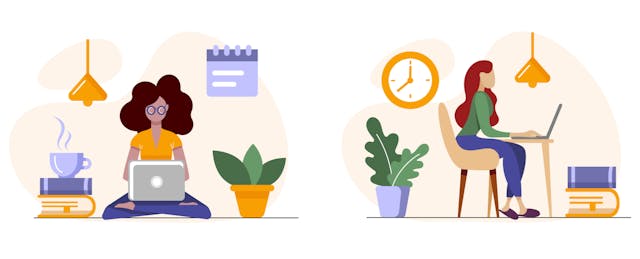At first the closures seemed short-term, maybe a few weeks at most. Many teachers posted up at their kitchen tables or logged on from their couches—a temporary setup to get by until schools reopened and regular classes resumed.
But day after day, it became clearer that there would be no swift return to normal. So teachers settled in—or at least tried—to their newly-virtual classrooms and made their home arrangements more manageable for the longer term.
Today, two months in, educators across the U.S. are delivering remote instruction from their dining rooms, bedrooms, living rooms and porches. And, in the process, they’re adapting to a completely different style and pace of the workday.
Take Janet Lake, who is used to standing all day to teach ninth graders at her school in the San Diego Unified School District. During the first week of distance learning, she tried sitting, but her feet swelled up. So she created a makeshift standing desk, where she now works from each day.
Or take Barbie Prince, a middle school teacher in Baltimore, who is used to walking around the room as she teaches and looking over students’ shoulders to monitor their progress. Her new classroom—limited to a window on a computer screen—feels very restrictive.
Some educators had home offices set up and ready to go before the pandemic hit, but most have since purchased new office equipment: desks, desk chairs, external monitors, keyboards, mouses, headsets, speakers and filing cabinets. The expenses—sudden but necessary—have added up.
Many educators described the switch from a traditional classroom to a so-called “COVID-19 classroom” in their homes as an unwelcome one, where student-teacher relationships are hampered, technology adds complications, and beloved teaching aids are sorely missed. Speaking to a Zoom classroom can feel both strangely chaotic and isolating.
Still, there are some conveniences. One teacher said she’s relieved she can now use the restroom whenever she has to go. Another said he can eat a snack when he’s hungry. Others described focused, prolonged periods of time in which they can work uninterrupted. For some, it’s a welcome change of scenery, going from a windowless classroom to a room in the house with ample natural light. Some say they’re enjoying more quality time with their families, too.
These are some of the things we learned when educators shared their experiences working and teaching from home—and snapped a few photos of their new setups. We rounded up the images—and more details—below.
Scott Merrick

Scott Merrick used to work in a computer lab in McMurray Middle School, part of Metro Nashville Public Schools. Now he works from a repurposed bedside table in the front room of his home, positioned in front of a large window that overlooks his garden, a maple tree and his neighbors’ houses. Around him in the room are his vinyl record collection, his guitar, his dog, a stationary exercise bike and a bin full of his writing—poems and short stories among them.
For Merrick, the setup itself is an improvement. But he hardly sees students anymore—only the ones who log in to his daily office hours, and those remain few since his class is not a core one and the district is still figuring out how to disperse laptops to everyone.
Kristen Messer

Like many people working from home, Kristen Messer moves around to different spots in her home throughout the day, keeping her “COVID-19 classroom” portable. She starts each day at her kitchen table, with her laptop, paperwork, microphone and light, and meets with students. She and her students—second graders at Stella Brockman Elementary in Manteca, Calif.—use a lot of digital tools, so she hasn’t put up any posters or signs in the background. When the video meeting is done, she “retreats to a quiet sitting room” with a different collection of work materials to do planning and recording.
She enjoys the video meetings, in that she can see her students during them, but it gets noisy. “I can’t tell you how many times I mute microphones during a session,” she says.
Her dogs, especially, seem to be pleased with the new setup, but she misses lunch with her colleagues.
Esther Schmitt

Esther Schmitt commutes between her bedroom and her living room to teach each day. The second-grade teacher at Los Angeles Unified had been working at her dining room table for two weeks, but when she heard the closures would persist, she made a new plan.
Schmitt bought a table and chair, a monitor with an integrated microphone and camera, and a rolling cart to keep up with all the paperwork she’s accumulating. “So there have been a lot of unexpected expenses from this transition,” she says. Schmitt has been teaching for 34 years and says this whole experience is a “first” for her, but feels that she and her colleagues “have pivoted and adjusted for the needs of our students.”
Barbie Prince

Barbie Prince, a middle school teacher at Krieger Schechter Day School near Baltimore, set up her desk at the kitchen table, then brought in two tables, a laptop stand, and an office chair with cushions “so that everything I need is nearby.” She misses all the space and affordances of her classroom—being able to move around to check on students, teach from different parts of the room and take her students outside as a group.
Jennah Castillo

Jennah Castillo enters her virtual classroom from a desk she set up in the corner of her bedroom. The desk has all the tools she uses to lead digital learning with her third grade students at De Anza Magnet School in El Centro, Calif.
Castillo tried to incorporate color schemes in her home setup that students would recognize from in her classroom: blues, greens and yellows. In the background of her new desk is her college graduation cap, with the outline of an apple and the words, “Now it’s my turn to teach!”
She says that while her new setup is comfortable and quiet, being at home actually has more distractions than in a traditional classroom.
Janet Lake

Janet Lake, a ninth grade teacher at Morse High School in San Diego, works in the family room of her home, using the fireplace as a makeshift bookshelf and printer table. She set up tall bistro tables to allow her to stand while she works, since she is so used to standing on the job.
Lake has added lighting, a rolling bookshelf, office supplies and a music player to her workspace. Not to mention all the technology she had to implement at a “breakneck pace.”
“My classroom was better,” Lake says, “but I feel like my students have gotten to know me personally in these past two months, more than I let them get to know me in all the first seven months combined.”
Stacey Roshan

Stacey Roshan, a math teacher and director of innovation and educational technology at the Bullis School in Potomac, Md., has been working from a desk situated in the corner of her condo. Since the start of school closures, she’s upgraded her setup to include a keyboard tray, keyboard and mouse and is waiting on the delivery of a new desk chair.
She is enjoying the prolonged periods of time in which she can concentrate and get through tasks. But there are a lot of downsides, too. “I miss being surrounded by people and my students,” she says. “A lot of things feel more draining and take longer to do, [such as] giving students feedback on work digitally versus in person.”
Roshan is a proponent of using technology to support teaching and learning, but she recognizes its shortcomings. Since she is not physically with her students to explain certain concepts or clarify the comments she makes on their assignments, she spends more time to ensure that her feedback is easy for students to understand. “Ultimately, I think there are more efficient systems we can put into place, but we didn’t have time to establish some of these routines in our classrooms since we moved to remote learning so quickly and thought it would be temporary, at first,” she says.
Bob Dillon

Bob Dillon, director of technology at University City School District in St. Louis, sometimes works from a hammock outside his house. “Everywhere in the house is a space for learning, based on time of day, mood and the other humans that circulate in this space,” he says.


